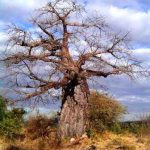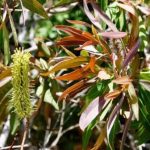TREE LIFE
APRIL 2002
AS BEFORE PLEASE CONFIRM WITH ANY OF THE COMMITTEE MEMBERS THAT THE SCHEDULED OUTINGS AND WALKS WILL ACTUALLY TAKE PLACE. SEE THE BACK PAGE FOR PHONE NUMBERS.
THE ANNUAL SUBS ARE DUE ON 1ST APRIL AND UNFORTUNATELY WITH ALL OUR COSTS SPIRALING UPWARDS SO RAPIDLY AN INCREASE TO $400 IS UNAVOIDABLE.
MASHONALAND CALENDAR
Tuesday 9TH April Botanic Garden Walk Please note the change of date to accommodate the trip to Matopos. Meet in the car park of the Botanic Garden at 4.45 for 5 pm where we will meet Tom and continue with the Rubiaceae family.
Sunday 21 April. Sonja O’Donnell has invited us to spend the day with her in her special piece of woodland near Marondera. In normal years it is a wet area as evidenced by the ‘old man’s beard’ hanging from the trees, with tree species similar to those we have seen at Gosha Park.
Bring your lunch and meet at 9.30 am.
Saturday 27th April A return visit to Rokpa Trust, the Meditation Centre.
NOTICE OF ANNUAL GENERAL MEETING
Notice is hereby given that the 52nd Annual General Meeting of the Tree Society of Zimbabwe will be held on Sunday 19th May, 2002 at a venue to be decided.
Any proposals/resolutions and nominations for office bearers should be forwarded to
P O Box 2128, Harare by Monday 13th May if possible, although proposals and nominations will be accepted from the floor.
AGENDA
- Notice convening the meeting.
- Apologies.
- Minutes of the 51st A.G.M.
- Matters Arising.
- Chairman’s Report.
- Treasurer’s Report.
- Election of Committee Members.
- Any Other Business.
MATABELELAND CALENDAR
No arrangements have been made for April. Contact Jonathan Timberlake if you would like to organize a future outing.
BOTANIC GARDEN WALK: 5 MARCH 2002
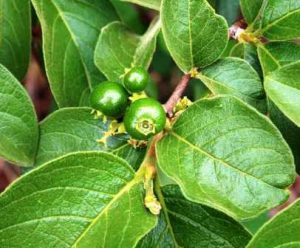
Vangueria infausta. Photo: Rob Burrett. Source: Flora of Zimbabwe
In today’s walk we continued with the Rubiaceae. First port of call was at a species of Vangueria. We are all familiar with Vangueria infausta (the Wild medlar or False medlar), a very common species in the miombo woodland but another quite closely-related species is Vangueria proschii (formerly called V. lasioclados). A glance at Coates Palgrave or Bob Drummond’s 1975 list of woody plants shows that this species was sunk under V. infausta and indeed the question still remains as to whether it is really distinct or not.
One important feature is that it dries blue, although this is not very helpful in the field. Another feature is that it has a slightly smaller leaf than infausta. It occurs in Kalahari sand and sometimes jesse in the west of Zimbabwe.
A further species mentioned by Tom which we saw on the Nyanga trip is a hairy V. apiculata. This species is now known as V. volkensii.
Why is V. infausta called the wild medlar? According to Wild, Biegel and Mavi’s Botanical Dictionary this is because the fruit resembles that of the true medlar, Mespilus germanicus.
How to separate Vangueria infausta from Vangueriopsis lanciflora? This is very much an old chestnut and it came up again today. Tom mentioned the flowers which are quite different: Vangueriopsis has long lobes, perhaps 20 mm, whereas Vangueria has much shorter lobes (perhaps 2-3 mm). I would normally recommend the difference that Vangueriopsis has branchlets which have a brownish powdery look. Oddly enough, the Vangueria we first looked at was also definitely powdery, thus demonstrating that it’s not always that easy to separate the two.
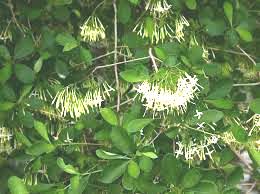
Pavetta gardeniifolia. Photo: Flora of Mozambique
On next to Pavetta gardeniifolia (formerly called P. assimilis). Tom remarked that it is quite a garden-worthy plant with its umbel-like cymes of white flowers. It is strongly foetid, much more so than the other common pavetta, P. schumanniana, which is poisonous to cattle.
We headed over towards the E districts kopje and at the base encountered a very rare species indeed: Tricalysia acokantheroides. Tom found this at Stapleford and this may be its only location in Zimbabwe. The opposite leaves are reminiscent of Acokanthera, although none of our species look mush like it. The bark was distinctive, vertically ridged with very narrow but strongly marked ridges.
In the forest was the inaptly-named Canthium inerme. The specific name means “unarmed”, i.e. without spines, but in fact the species does have them and plenty of them scattered along the oldish wood. The bark is a distinctive pale grey and is smooth. It is a plant of forest edges at high altitudes.
Tom also mentioned another spiny species of Canthium, namely C. obovatum. This occurs in forest outliers at Juliasdale and we may have seen in on our walk at Nyazengu.
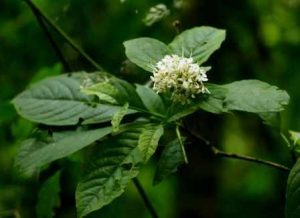
Pavetta comostyla. Photo: Bart Wursten. Source: Flora of Zimbabwe
Further pavettas were seen here. One very attractive species is Pavetta comostyla, which belongs to the comostyla/ inyangensis complex. this species has very striking subumbellate flower heads. Again, it might have horticultural potential. It is a plant of forest edges. Also present was Pavetta umtalensis, a species of high altitude forests. A similar species, Pavetta muelleri, named after our leader, has recently been named.
Related to Tricalysia, but now in a separate genus, is Sericanthe odoratissima. This is the forest form of the savanna S. andongensis. Tom reported that 3 forms of this species have been recognised in rain forest – but whether these have been formally named or not I don’t know.
Finally, the genus Rytigynia. Rytigynia macrura occurs in forests in the Vumba (e.g. Bunga) and has distinctive pale green leaves and is deciduous. This is strikingly different from the usual evergreen, dark green and glossy leaves of most forest trees. A second species is R. schumanniana, recorded from mermaid’s Grotto and a third is R. umbellulata which grows in the Zambezi valley.
Once again, a walk full of interest. Many thanks to Tom for sharing his knowledge with us. We expect to continue with this large family next month.
-Mark Hyde
TREE SOCIETY’S VISIT TO NYANGA
In the next few pages are the accounts of the days the Society spent at Nyanga from 1st to 4th February 2002. It may be seen that we had an exceptionally successful trip, which attracted record numbers of people.
Special thanks from the Society must go to Tom Muller for acting as our leader and for making available his skills and insight in the field; we were extremely privileged to have him. We would also like to thank: Dido DeSwardt, for her considerable contribution, Tim Tanser, for hosting the Society on the Sunday; and last, but by no means least, Maureen, who organised the weekend.
-Mark Hyde
Friday, 1st February 2002
10.20a.m. after a late start and long, inspiring drive across the Pungwe Drift and the ridges parallel to the river, some 24 enthusiasts set off on the Nyazengu trail, below Mt. Inyangani. Many flowers distracted the eye – moraea’s, compositae, euphorbiaceae- but -‘trees are the object, so, onwards, upwards and downward everyone, ‘ became the theme song. But how could we ignore the welcome into our first patch of forest? Pink Geranium ?incanum, white Viola abyssinica, bright pink Impatiens silvipatiens, and paler I. sessiliae, lead our feet onto a small wooden bridge over a tiny stream, and there, with its foot in the water was Ilex mitis, with yes, a few sharp teeth on the leaves, but no pale patches in the lamina, and no seed.
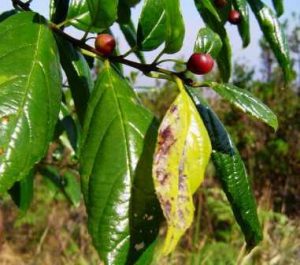
Rhamnus prinoides. Photo: Bart Wursten. Source: Flora of Zimbabwe
But Rhamnus prinoides leaned over, offering not-yet ripe berries to birds, its familiar serrated leaves particularly glossy. Maytenus heterophyulla subs. thorneyi, in green fruit, looked more like a Dovyalis than the M. Heteroppylla we are accustomed to, with its somewhat rounded, very glossy dark green leaves and slender pale thorns, but a careful look through a lens showed the dark gland tips to the leaf serrations. Diospyros whyteana with its shiny, hair-fringed leaves, was to be seen frequently in the forests, in one place the gooseberry-like fruit fallen on the pathway, yielded a few, hopefully viable, seed. Podocarpus latifolius were nowhere as big as we expected, but its long, dark green leaves, and its general habit, were unmistakable.
Then out into a field of white-flowered Scabiosa austro-africana, onward and upward to the next patch of forest, passing the Petrol-bush, recently re-named Erica benguelensis (GROAN – WHEN will the taxonomists take pity on the ordinary people?), which may be so useful getting the fire going for early morning coffee, but must add enormously to the damage done by veld fires. Small Myrsine africana hugged themselves amongst the rocks, bearing nary a fruit, and on another larger boulder we saw Aloe arborescens and Cussonia spicata, sheltered from the fires that swept through the area last October-November. In this next patch we found Rapanea melanophloeos, a dominant constituent of the outer edges in moist areas, whilst inside the forest, Psychotria zombamontanum was the dominant understorey tree to tall Afrocrania volkensii. The tall trunk and long buttresses typical of Afrocrania in the main forest, were not quite as evident here, but a lower shoot did provide some leaves so that we could pull them apart to see the connecting threads. A clear running stream was to be jumped over; – water to drink, and the ground cover of Selaginella dregeana brought to mind childhood dreams of fairyland, with small Dovyalis lucida, its leaves only slightly serrated, making the miniature tree in the landscape. On the outer edges the shrubby Sparrmannia ricinocarpa mixed with Rapanea and more small flowers to lead us into twisty, ‘mind-the-edges-of-the-small-ravine’ paths on towards the main forest. But first, to the side of a lower ravine, tall Schefflera umbellifera held digitate leaves stiffly up to the sky.
On route to the main forest, a sad sight where the rare Widdringtonia nodiflora showed how severely they had been damaged by those last horrible fires, for the recovery looks to be very slow. But- ‘no time no time, hurry on’, the main forest still lay ahead. We did note as Dr. Muller pointed out the specific water and altitude requirements of many species, that the Schefflera, Rapanea, Hypericum revolutum, occurred in the better-drained areas, whilst Afrocrania and Peddiea africana were to be found in the moister, higher deep forest areas. His contention is that there are only naturally-occurring grasslands in the soggy patches that are too wet even for the trees, and that before man came to upset the ecology of the area with his need for fields and firewood, most of the montane area was heavily wooded, and the frequency of fires has prevented the present grassy areas from being naturally re-forested. But, then, how to explain the very high range of grassland flowers, small pretty ones, for which Nyanga is so well-known?
A number of the stream beds were dry – unusual for the time of year but at one swiftly running crossing -‘jump, catch my hand, careful is is slippery’ we found Protea drakensbergii almost 2 m tall (oh, yes, another name change to note down, from P.Caffra). and Inyangani endemic, Myrica microbracteata, shrubby, with narrow dull-green leaves. More watch-your-step down a steep track, and at last the main forest was upon us, the entry crowded with the tallish broad-leaved clumpy grass, more of the shrubby Sparrmannia, and Hypericum revolutum, not noticeably curry-scented that day. A familiar leaf greeted us – Calpurnia aurea, a small specimen here, but attaining a reasonable size further on I was told. Inside we saw many Peddiea africana, their leaves also very shiny, with wavy margins, and the trees here reaching a height of up to 10 metres. This member of the Daphne family is to be found from the Mocambique coastal area right up to Inyangani, an amazing range of altitude and climate – it was certainly very common in the forests that we explored. Both it and Maesa lanceolata had finished flowering and green fruit were forming, there will be food for birds later in the year – was this why we saw and heard so few birds, not much food as yet?. A little way in we came to an unusually tall Erythrococca polyandra -we looked for a tarzan to climb and find us some leaves, but once again a side shoot provided the clues we needed. And at last Dr. Muller found the two Syzygiums he had been wanting to show us – Syzygium masukuensis with its ‘cafe au lait’ coloured slash in the pale brown bark, the leaves far too high for us to examine. This tree only occurs at high altitudes, whereas the other, Syzygium guineense subs. afromontanum although also occuring in the montane mist-belt area, is to be found somewhat lower down. Myrica pillulifera was here a big tree, we saw Aphloia theiformis minus its ‘Albino berries’ Rytiginia macrura with its inter-petiolar stipule clearly seen, Halleria lucida in more open patches very shrubby, as we had seen it on our way to the assembly point. Xymalos monospora, with quilted leaves, the margins lightly toothed did not give off a lemony smell, and the bark did not have the noticeably concentric rings, which distinguish it – a small disappointment.
The forest floor was carpeted with Selaginella, or more Impatiens, or Viola, a very attractive grass, a groundcover whose name slipped the expert, ferns abounded, moss grew on tree trunks, with tiny epiphytic peperomia’s amongst the moss – it was all splendid enough. And then, WOW! We came upon the most amazing scene. Two large, rectangular chunks of rock stood in the pathway, like monuments, covered in moss amongst which grew a thousand flowering Streptocarpus, their pale blue flowers delicately halting our footsteps. Another-worldly ‘Lord of the Rings’, scene to take our breath away. ‘Right you have gazed enough, on to the high forest!’ But by this time, 2p.m. the pangs of hunger, and aching muscles could not be ignored, and soon we had to stop, find damp seats on mossy logs, sip our water and enjoy our sandwiches, and ponder in friendship, on our days in Zimbabwe. From this point the party broke up, some to take the scenic walk to Nyazengu Falls, the main body to press on to the montain forest section, and four of us with wonky knees or metal-spiked ankles to return to the cars by the way we had come – it still took us two hours without stopping to look at plants, although catch-your-breath stops gave us chance to enjoy the views that we had not had on the way out. The mountain’s last wave of mist and guti, sending nervous tinglings down our backs (we from Chegutu and Banket well remember the children lost on Inyangani), could not rob us of the joy of having seen what we did see, of having been to places we shall never go to again, of sharing this love of beauty and knowledge and good companionship.
-Ann Bianchi.
NYAZENGU: 1 FEBRUARY 2002 (continued)
After lunch, a number of groups turned back in order to return to the cars by different routes. However, a group of us went on, led by Tom, towards Pig’s Patch where there is some very unusual and interesting forest.
We crossed a large, open patch of sunny grassland and, leaving Dagmar there reading a book, turned off to the right and slightly downwards into a patch of forest. I should add that at this point our altitude was c. 2000 m and we were in effect on the slope of Mt Nyangani.
Here were a number of rare and interesting trees. An important canopy tree was Syzygium masukuense (Small-fruited waterberry) which is a very rare tree in Zimbabwe. This has very dense foliage with the occasional red leaf so typical of Syzygium.
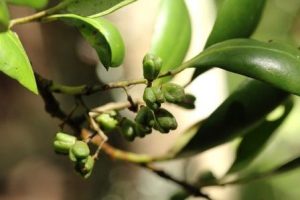
Pterocelastrus echinatus. Photo: Bart Wursten. Source: Flora of Zimbabwe
Another canopy tree was the ubiquitous and immensely variable Rapanea melanophloeos (sometimes called the Cape beech) identified by its streaky-bacon slash. We saw this over and over again during the weekend in many forms and habits and it puzzled us repeatedly.
In the understorey was Pterocelastrus echinatus (Hedgehog tree) so called because of the warty protuberances on the fruit. Another very local shrub or small tree seen was Canthium oligocarpum subsp. captum, again another rarity.
In addition to Schefflera umbellifera, (Forest false cabbage tree) which was a common canopy and forest edge tree, we also saw the large liane in the same genus, Schefflera goetzenii. This also has digitate leaves but these are rather broader than umbellifera. Other species seen included: a grove of Cyathea manniana (Spiny tree-fern); Dovyalis lucida (Glossy dovyalis) the leaves of which are reputed to be so shiny you can see your own reflection in them!; young leaves of the endemic and very beautiful Scadoxus pole-evansii; Cassipourea malosana and Lasianthus kilimandscharicus (the Sky-berry). The latter species has remarkable blue fruits – although we didn’t actually see these on this occasion.
By a stream in the forest were some enormous specimens (perhaps 10m tall),of Hypericum revolutum (Curry bush) numerous plants of a Streptocarpus clinging to the rocks and in the bed of the stream was a little non-stinging nettle, Elatostema monticola.
Apart from these more unusual things we also saw the trees which had been our staple diet that day and were to be the next day, namely: Podocarpus latifolius (Yellow-wood) and in the understorey Aphloia theiformis(Albino berry), Peddiea africana (Green flower tree) and Diospyros whyteana (Bladder-nut)
By now it was mid-late afternoon and we decided to begin the long walk back. At this point we made a mistake and, led by Tom, began to climb steeply up the mountain. Although there was a general view at the rear of the party that we were going up too much, Tom climbed on, convinced that we would soon turn to the left and re-find the sunny open patch.
The going was difficult (there was after all no path) with thick bush and climbers, all on a generally steepening hillside. Those at the back with stiff legs struggled onwards and upwards. As we ascended, the sun went in and the mist came down – although rather thinly at that stage – but no open patch came into sight and if anything we were in even thicker bush than before.
Eventually, even those at the front realized that they were lost and a halt was called. At this point the idea of spending the night on the mountain was beginning to exercise my vivid imagination. I, very belatedly, pulled out my GPS and in by now spitting rain consulted the readings and the maps. It turned out that we were no more than 100 m or so from where we wanted to be but far too high. This was really just confirmation of what many people had thought but it was comforting information. A discussion took place and it was agreed that we would retrace our steps.
This we did but after a while a change of plan was agreed and it was decided that we would go straight down the steep slope, where we were bound to hit the path. After some initial scepticism this was agreed to and we all proceeded gingerly, mostly on our bottoms, down the steep slope. Kurt Braunstein went on ahead to see what was coming and some vaguely reassuring reports floated back through the trees. As we descended, the slope grew less steep and as if some celestial film director was in charge, the mist cleared and the sun came filtering through the trees. Cue for orchestra Shortly afterwards we hit the path and re-found Dagmar.
With hindsight, we did not handle that very well. The incident shows how Nyangani is not to be trifled with. It was a mistake to leave one member of the party on her own and also a mistake to let the front of the party carry on for too long. Many people also found that they had brought with them no shelter, no food, no warm clothing so that a night on the mountain would have been a very miserable event indeed.
Even now our adventures were not over as it was late and a very long walk awaited us to the cars. By the time we were close to the cars, night had come on, together with intermittent thick fog and for the last 100 metres or so it was difficult to make out the rocky path.
Just to add to the fun, a thunderstorm came on, with heavy rain and swirling fog and it was a difficult drive back across the Pungwe drift – handled very well by the drivers of the three vehicles.
We got back to our cottage at about 8.45 p.m. for some frantic defrosting of food and a very late meal. All in all a memorable day which turned out well in the end.
-Mark Hyde
“FAR AND WIDE” : 2 FEBRUARY 2002
After all the excitement of the previous day, today was much a more straightforward and quiet day of treeing. The group of 34 (almost too large a group really) gathered near Far and Wide and, led by Tom, set off along the footpath towards the forest containing the endemic Scadoxus pole-evansii, which was the main object of the day. In many ways, there were just too many people for one leader on a narrow path and in practice the group tended to fragment into smaller groups.
At first we walked through open bracken scrub with numerous herbs and ferns of interest and also some shrubs. It wasn’t particularly interesting for those with a strict interest in trees only but it was very good botanising generally. I regret to say that at this stage I fell behind somewhat with a group at the rear. However, some woody plants were present. Apart from the ubiquitous Hypericum revolutum (Curry bush) there were Maesa lanceolata and Aphloia theiformis (Albino berry). One of the most remarkable finds here was a climbing Asclepiad, possibly a Ceropegia, with rather striking flowers which were orange inside the connate lobes. Darrel Plowes showed us how to separate two species of Impatiens: I. sylvicola which has small flowers with a dark centre, as compared to I. cecilii which has larger flowers without a dark centre.
After a while we entered the forest and immediately were in a different world. Tom pointed out that you could often tell pristine forest (and presumably woodland too) by the presence of a range of tree ages from very young trees to very old ones. Secondary or regenerating forest on the other hand tends to have a preponderance at one particular age.
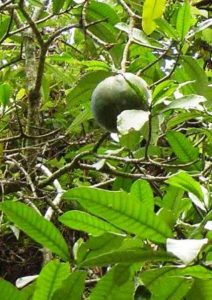
Tabernaemontana stapfiana . Photo: Bart Wursten. Source: Flora of Zimbabwe
The main object of the visit was to see the Scadoxus in flower and although many were over, we had no difficulty in finding the extraordinarily attractive, umbellate inflorescences. A number of other interesting species were seen. Tabernaemontana stapfiana (the Soccer-ball tree) has, as its name suggests, very large fruits (Coates Palgrave gives “from 18-20 cm in diameter”). The family is the Apocynaceae and the tree is typical in having opposite leaves which contain a milky latex. Fruits begin as pairs, but often one aborts leaving the other to grow to maturity. I have never known anyone to be hit by a falling fruit but presumably it is no joke. Also present was the forest tree Rytigynia macrura (Rubiaceae), just written up for the March Botanic Garden walk and numerous specimens of the Yellow-wood, Podocarpus latifolius. Another forest tree we saw, which has broad shiny leaves is Trimeria rotundifolia (Flacourtiaceae); the specific name is indeed an accurate one as the leaves are usually circular.
Two climbers were noticeable in the forest: Jasminum abyssinicum was one; this is a jasmine with compound leaves and can therefore be readily separated from other Zimbabwean species except for Jasminum fluminense. However, habitat easily separates these: fluminense occurs in riverine vegetation, often at medium and lower altitudes, whereas abyssinicum is a species of forests. The other climber seen was Secamone alpinii. This is another Asclepiad and like the Tabernaemontana has opposite leaves and milky latex. Interestingly, modern thinking is to sink the Asclepiadaceae (and the Periplocaceae) into a large extended Apocynaceae.
A shrubby species with alternate leaves and long whippy stems was later identified by Tom as Gerrardina eylesiana. This rare shrub was completely new to me. It is from the family Flacourtiaceae and occurs in Zimbabwe only in the east.
Incidentally, care needs to be taken with the name for this genus because there are three in the Zimbabwean flora all with similar-sounding names:
Only the names are similar – the plants are of course totally different.
| Name | Family | Life form (in ours) |
| Gerrardina | Flacourtiaceae | Shrub |
| Girardinia | Urticaceae | Herbaceous stinging nettle |
| Gerardiina | Scrophulariacea | Herb |
Also seen in the forest walk was a tree with yellow sap. This was Garcinia kingaensis, the forest garcinia. As with the other two species of Garcinia in Zimbabwe, in order to see the sap you need to fold the leaf in half so that it cracks but does not come apart. Yellow blobs of latex will then be visible along the line of the crack.
Another fairly common, prickly, forest-edge species seen was Toddalia asiatica. This has 3-foliolate leaves, translucent gland dots in the lamina and fruits like small naatjes.
It was also very pleasing to see frequent shrubs of Pauridiantha symplocoides. This is very distinctive with rather pale-green delicate leaves and is very far from being just another “E Districts Rubiaceae”.
Eventually, we emerged onto an open slope with a fantastic view of the Honde Valley and “the Needles” and we ate lunch and compared notes on the plants we had seen.
After lunch, the party tended to fragment again. This time I was with a party which included Tom and having walked back through the forest we turned left and (in effect) walked back along the cliff edge above the Honde Valley. Much of interest was seen and it was an absolute pleasure to have Tom with us to provide instant answers.
As an aside, the fern flora was magnificent. Mary Clark showed us a fern (Arthropteris monocarpa) in which the rhizome climbed a tree trunk, emitting fronds at regular intervals. Also present were two species of epiphytic Lycopodium spp.
Mary also pointed out a possible further specimen of Protea asymmetrica and comparison at the Ringing Rocks site later confirmed that this was correct.
Into the next patch of forest and there was again Canthium oligocarpum subsp. captum, which we had seen at Nyazengu the previous day, and an unknown tree with opposite leaves, quite long-pedunculate inflorescences, lenticels and a pale lemon slash. After much debate and discussion, Tom named it; it was Cassinopsis tinifolia.
Another puzzle which presented itself was – how to separate Rhus chirindensis from Rhus tumulicola (formerly known as R. culminum)? I had never seen the latter before and hadn’t realized that the two are quite similar in appearance. It appeared that both were present. A further puzzle was the very variable Myrsine africana – were there two or only one?
The day finished with a quick dash to the “Ringing rocks” to see the rich flora before the rain came down.
All in all, a memorable day. Far too many plants were seen to cover in one article and I have had to be highly selective in this write-up.
-Mark Hyde
TIM TANSER’S PLOT – 3/2/02
We finally wiped all the marmalade off and mobilized at around 10am. The walk took us up the hill behind the Tanser’s cottage. Besides the forest, we had the added interest of ancient ruins – the final objective being a fort at the top. Initially we climbed through pine. This in itself was interesting, as prior to a fire in 1988 the hill supported one lone pine. It now supports a veritable forest, which the Tansers are trying to contain. The forest floor was dotted with beautiful large cream mushrooms, many of which had been guzzled by some 4-legged forest dweller. However, the sample that Sue took down to have I.D’d was apparently one of the toxic ones. There was evidence of porcupines in the forest – both fresh droppings and quills. I’m not sure if they indulge in fungi, but they readily eat the bark of Spirostachys africana, despite its toxic latex. Perhaps these rodents have discovered some outstanding forest fungal ‘trip’ – sort of a ‘porcupine high, porcupine high’. Neil Diamond’s got it all wrong.
Early on we encountered the remains of ancient aqueducts, wells and terracing. Considerable debate ensued as to exactly why the people left the valley floor, and what they grew in these very acidic soils. No consensus was reached on that one – so if anyone has the answers it would be good to know.
The forest was much the same as on Day 1 and 2, with Maesa lanceolata, Macaranga melliferaand Schefflera umbellifera being the 3 main pioneer species. ‘Streaky bacon’ Rapanea melanophloeos, with its distinctive upright growth habit was common, as was Psychotria zombamontana.
Maesa lanceolata caught me continuously, with its young leaves having distinctly toothed margins, mature leaves often being entire. We came across some in flower on the Mtarasi walk – really quite striking white inflorescences -van Wyk’s photo does not do them justice.
Macaranga mellifera with minute golden glands covering the underside of the leaf, and 2 larger glands on the upper leaf surface, just where the petiole and leaf base join. Two different gland types on a leaf. Any ideas as to their function?
Myrsine africana is a beautiful understory shrub that apparently has gland-dotted petals. Its small, almost spherical, glossy leaves are striking. It’s also a larval food plant for Poecilmitis lycegenes .. a little orange and black spotted butterfly.
Vangueria apiculata the ‘tangle-flowered wild medlar’ caused some confusion with its hairy leaves. I think in the end we had hairy and smooth next door to each other. Its fruit are edible, but it depends how hungry you are according to Tom. There were none to try.
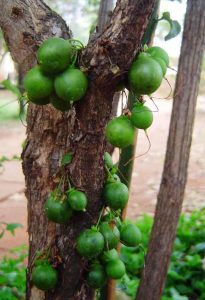
Halleria lucida. Photo: Bart Wursten. Source: Flora of Zimbabwe
Halleria lucida also has edible fruit, though one book says that they are ‘sickly sweet and dry the mouth’, and another says ‘edible but not tasty’. I know of yet another little book that says ‘do not waste your time eating food that is not truly desirable’. However, when in the forest it is always handy to have some idea of what is edible – especially if there’s any possibility that your precision, Swiss made direction finder could lose his way! H. lucida is also used as a charm against bad weather, evil spirits, and wizards – it’s worthwhile notifying Harry Potter on this one.
Its wood is hard and durable, and it has been referred to as the ‘walking stick’ tree – but most of us already had a wattle stick, per kind favour of Darryl.
Gerrardina eylesiana – another stunning understory shrub. It has a distinctive reaching up and drooping down growth habit, and eye catching coppery-red, glossy new growth. Another possible for the garden I’m sure.
Xymalos monospora, the ‘unfaithful scruffy’ tree. It has no set leaf arrangement, the leaves being opposite and alternate on the same branch. To add to the confusion, some leaves are entire and some are toothed. It must be a challenge in any dichotomous key system. It does however have 2 distinguishing characteristics – the bark flakes and leaves distinctive concentric rings and whirls, and the leaves have a characteristic ‘quilted’ appearance.
Clausena anisata was a regular find, usually in the form of thin, scraggly trees in the forest. The leaves I crushed definitely had a pleasant anise smell, though I believe that’s not always the case. Apparently they can be used to flavour curries and are also quite flammable. No less than six species of swallowtails breed on the tree, including the Emperor Swallowtail, which is the largest butterfly in southern Africa.
Round about now our walk split into two – the ramblers stayed down below, and the climbers departed for the fort at the top. Tim led the climb up with 12 of us in tow. At this point I have to admit to being somewhat impressed by our slightly older Tree Soc. Members. The upward climb did not involve the usual switchbacks – just a straight up grapple with the slope, which was considerable, hauling on trees and shrubs to stop the downward slide. All I can say is that it was not the septuagenarians that brought up the rear. I’m also going to take steroids when I get to that age! Our group was truly amazing.
The fort at the top was impressive.
Toddalia asciatica, a huge thorny rope, has been cleared from the center of the fort. It’s a member of the Rutaceae or citrus family. It bears little fruit, very similar to regular lemons, but smaller, and is armed with prickles mounted on impressive bosses. Not being true thorns, these are quite easily flicked off. Despite this, thorny rope can be used effectively to ‘rub along the chin of your enemies’. This handy little tip was contributed by Tom, and needless to say had us all on our best behavior.
Urera trinervis was interesting, with its aerial adventitious roots. It’s a climbing non-stinging nettle, so is not useful on enemies. At intervals along its stem roots just ‘pop’ out. These may be produced in response to contact with other plants. The new growth lacks the roots, but has attractive, short, stiff, red hairs on the stem.
The one thing that I have not yet mentioned is the importance of Tom’s knife on these forest excursions. ‘Slash’ became a well-used word – and any tree with leaves out of reach got one, the aim being to note the colour of the phloem and the hardness of the wood. Armed with this info, Tom would then I.D. the tree. It was most impressive. We had:
‘streaky bacon’ Rapanea melanophloeos
pink slash Kiggelaria africana
soft slash Schefflera umbellifera
orange underbark of Pterocelastrus echinatus
yellow sapped Garcinia kingaensis
kids’coffee or café au lait Syzygium afromontana
We also had a bright red Mullerine slash of the paw – self inflicted I must add – not any sort of payback for hours spent on the steep slopes of Mt. Nyangani!
Yet another great weekend in the good company of Tree Soc. members. Many thanks to those who organised the outing and accommodation, and to those who led the walks. Such a wealth of knowledge to draw on and so freely given – even when asked for the 6th time!
-Lynne Evans
JULIASDALE OUTING: DAY FOUR Monday, 4th February 2002
Monday dawned fine and warm. Those members of the expedition who had commitments at home had departed the afternoon before, but there were still 15 remaining to enjoy the botanical and scenic delights of the Honde valley. Our original intention had been for the more energetic members of the party to walk to Buwu village, halfway down the escarpment, where they would be collected by the remainder in vehicles and transported to Aberfoyle Estate. However, rumours of political activity in the valley made us reconsider the advisability of a party of strangers wandering off the beaten track “looking at trees”. Instead, we explored a belt of forest at the top of the escarpment on the path to Buwu, and then went on by car to Mtarazi Falls for the afternoon; perhaps not as adventurous, but well worth while.
We parked the cars at the end of Pamushana Road, at the edge of the Honde escarpment, and set off down a winding, and occasionally steep and slippery, path through dense rain forest. The dominant species was Macaranga mellifera, which we had now learned from Tom indicated secondary forest, probably regenerating after clearing less than a century ago. Occasional giant Schefflera umbellifera provided evidence of the early stages of succession to primary forest, and we found one small Syzygium guineense afromontana growing in a clearing. The understory consisted of the same species that we had seen on the previous days, with Psychotria zombamotana predominating, together with some Pavetta and Crotalaria species in the lighter areas that we had not seen before. Maytenus (Gymnosporia) mossambicensis was common, which we recognized by its spines, glossy dark green leaves, and single fruits on long stalks. The blue flowers of Clerodendrum eriophyllumattracted our attention, and we all had to experience the foul smell of the leaves that is so characteristic of the genus. Isachna sp., one of the less common forest grasses, grew alongside the path, with delicate flower heads seemingly suspended in the air above the leaves.
We left the path at the top of the steepest section of the slope to follow a low stone wall to an unusually large pit structure in very good condition surrounded by the remains of other walls. Had this been built originally in the forest, or had the forest regrown around it? What was interesting was that the species of trees growing in and around the ruins were those of more mature forest; Rapanea melanophloeos, Aphloia theiformis, Xymalos monospora,Kiggelaria africanaand an unusually large Maesa lanciolata. Here too we saw our first fig of the weekend, Ficus craterostoma, with its characteristic truncated leaves and a network of aerial roots forming a strange arch over a section of wall.
As we descended the main path the woodland became more open and disturbed, possibly because of more recent cultivation, until we emerged into open grassland, with magnificent views down into the valley and up to the cliffs behind us. Clumps of wattle and burnt skeletons of shrubs were the only trees at hand. The prospect of walking down through this unattractive vegetation in the increasing heat in the hope of finding something more rewarding, and climbing back up again, did not appeal. We sat ourselves in a row along the path in a patch of shade and ate an early lunch, much to the astonishment of passers-by, who climb up and down the path on a daily basis.
At Mtarazi Falls, where we spent the afternoon, we came face to face with the rain forest trees which we had been gazing up at for the last three days. The stunting of the trees in the little patch of forest by the car park brought their leaves and fruit down to eye level. The fact that the trees were labelled was a bonus. We were able to appreciate the large, palmate leaves of Schefflera umbellifera, to see the purple berries clustered along the stems of Rapanea melanophloeos beneath the strap-shaped leaves, and to recognize the round, rough fruit of Kiggelaria africana. The Rhus chirindensis, with trifoliate leaves with wavy margins, were laden with berries and were easy to distinguish from Rhus dentata, which has toothed leaf margins.
Beyond the forest on the path down to the viewpoint we entered a completely different ecosystem of grassland and shrubs. The experts enthused about Trimeria grandifolia, Cliffortia nitidula, Myrica pilulifera, Kotcha thymodoria and Vangueria apiculata. I was more impressed by the magnificent views into the valley beneath, and the thread-like falls down the cliffs. The forest in the valley grows up to the base of the cliffs, and with binoculars it was possible to identify some of the species. It was also great fun to watch a large, unidentified raptor taking off from the canopy of the forest and making its way up the cliff face in the rising air of the thermals. It had to keep very close to the rock face to catch the lift. Occasionally it misjudged the distance and drifted into the cold downdraught accompanying the falling water, from which it had to flap vigorously to extricate itself. We lost sight of it before it reached the top.
The party drifted back to the shade of the forest by the car park and then made its way to Dido’s cottage for tea and final farewells; a perfect ending to a most enjoyable and interesting weekend. It is experiences such as this that make today’s problems in Zimbabwe endurable.
-J.A.Lawrence
FIRST SIGNS OF WINTER
Today is only the 6th of March and I have already come across trees at Charmwood that are going into their winter mode.
The leaves of Steganotaenia araliacea (popgun tree) are turning brown and shrivelling up, and those of Hymenodictyon floribundum (red firebush) have started to turn the vivid reds and scarlets that are so characteristic for a few weeks or months before leaf fall.
Perhaps the very poor rainy season we are having this year-or have already had!-has contributed to these early signs of winter, and elsewhere in the country the leaves of Sterculia quinqueloba and Kirkia acuminata (and others) should have started to turn yellow.
This reminds me of something from the golden years of my youth that I had nearly forgotten. A former boss, who was an avid cutter-down of good-sized mukwa for furnishing his house, would always spend time studying the trees he coveted before actually having them felled. If a mukwa lost its leaves early in the year, and was late in flushing it, was a signal to him that the tree contained a lot of heartwood and only a narrow band of sapwood; but a mukwa that retained its leaves late into the year and then flushed early was judged to have a wide band of sapwood and comparatively little heartwood. I never knew him to get it wrong.
-Lyn Mullin
A BAOBAB ROOT NOTE from Peter Taylor.
Two baobabs within the Gonarezhou National Park with which I had dealings may interest the readers.
At the site of Fishan’s Village on the south bank of the Lundi river (now called Rundi, but known as Lunzi by the Shangaans) just upstream from Chilojo Cliffs was a quite large baobab known as “Bvekenya’s Baobab” Bvekenya was the name given to Cecil Barnard by the Shangaans. As you know, Barnard was a renowned ivory poacher who operated in the south-east Lowveld during the early 1900s and was made famous by T.V. Bulpin’s book The Ivory Trail. When operating in the Fishans area Barnard would set up base within the shade of this tree. When I was working to Tsetse Control in the early 1960s I would also sometimes camp next to Bvekenya’s baobab. The Shangaans still spoke of Bvekenya and some of his off-spring still lived there. Sadly, Bvekenya’s baobab is no more – victim of elephant pressure before culling operations began.
The second baobab is a much more modest tree and is probably still in existence. It is on the opposite bank of the Lundi and much further down stream, not too far from Pokwe Pool. This tree also has connections with an ivory poacher, a Mocambique Shangaan named Xadreque (Shadreck would be the English spelling of his name). I met Xadrique at the height of the liberation struggle during the late 1970s and he showed me this tree which he referred to as his “office.” It was a short, squat tree hidden away in the thicket of other trees, perhaps 4 metres high with a disproportionately wide circumference with a small hole at the base just large enough to squeeze through into the hollow, surprisingly roomy interior. Xadrique used his “office” both for shelter and storage whilst “working” the Sabi/Lundi confluence area.
HOW TO JOIN THE TREE SOCIETY
Membership subs are $400 per calendar year.
Mail a cheque for $400, made out to the “Tree Society” to PO Box 2128, Harare giving full details of your name, postal address and email address and you will be including in the mailing list pending confirmation of acceptance of membership
MARK HYDE CHAIRMAN


